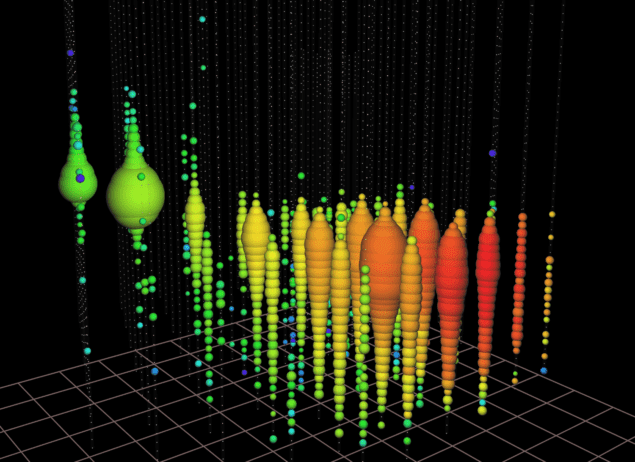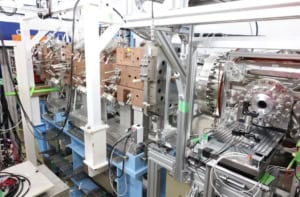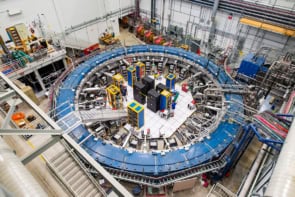
The IceCube Neutrino Observatory may have detected a tau neutrino with an extraordinarily high energy of about 100 PeV, according to a new analysis done by Matthew Kistler at Stanford University and Ranjan Laha at Johannes Gutenberg University Mainz in Germany. The detection was made in 2014 and could provide a glimpse of hitherto unknown astrophysical processes.
Situated at the Amundsen-Scott South Pole Station, the IceCube detector is an array of thousands of light detectors (photomultiplier tubes) embedded throughout a cubic kilometre of Antarctic ice. Occasionally a neutrino will collide with an atom in the ice and produce a charged lepton (electron, muon or tau) that is moving faster than the speed of light in ice. This creates a track of Cherenkov light in the ice, which is picked up by the detector array. By studying the track, IceCube physicists can work-out the energy of the neutrino and its trajectory into the detector.
Neutrinos come in three different flavours (electron, muon or tau) and this dictates what type of lepton is produced in the collision. An important challenge for IceCube physicists is to differentiate between the three leptons, which is not always straightforward.
Long tracks
In June 2014, IceCube saw light from a charged lepton that deposited 2.6 PeV in the detector – an extremely large amount of energy that had never been seen before in the detector. Initially, physicists assumed the event had been initiated by a muon neutrino with an initial energy of at least 10 PeV. Muons had been responsible for most previous tracks measured by IceCube, mostly because these leptons have ideal properties for creating long tracks of Cherenkov light. However, the highest previous muon neutrino energies seen by IceCube were at around 2 PeV – leaving a mysterious gap in energy up to 10 PeV.
Writing in Physical Review Letters, Kistler and Laha argue that it is unlikely that the signal is related to a muon neutrino created by known astrophysical processes. They have also calculated that it is possible that the event could have been caused by a tau neutrino – an elusive particle that was discovered just 18 years ago at Fermilab. Tau leptons are very short-lived, which means that they would normally decay before creating a long track in IceCube. However, Kistler and Laha reckon that a tau lepton created by a neutrino with an energy of about 100 PeV could leave such a track.
New processes

IceCube finds cosmic neutrinos at the South Pole
If this proves to be correct, it could open a window to new high-energy astrophysical processes that can create such high-energy tau neutrinos. “Assuming this is the case,” says Laha, “this opens up completely unexpected possibilities, namely that astrophysics should start looking for neutrinos with energy of up to 100 PeV”.
Kistler and Laha plan to study the 2014 event more closely, and also hope to develop new ways to identify different charged leptons based on their individual tracks.



